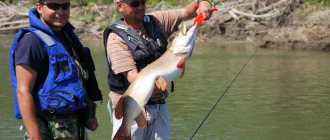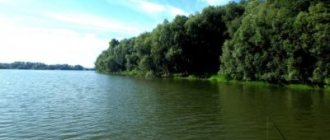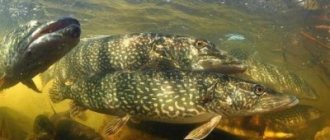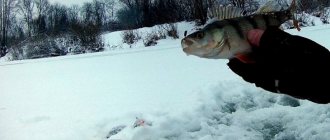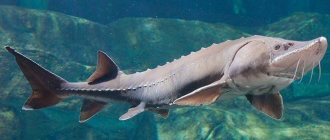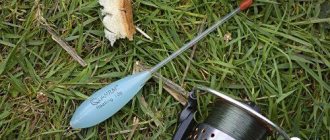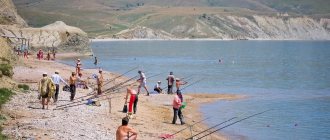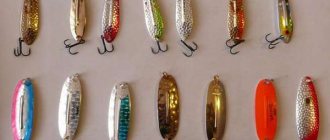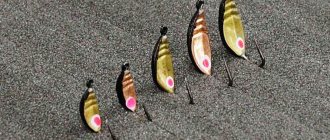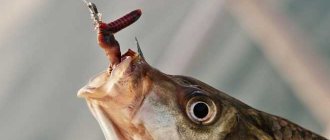Features of Kamchatka cuisine
Once upon a time, traditional Russian cuisine and the gastronomic world of Kamchatka had little in common. The indigenous population of Kamchatka - the Chukchi, Aleuts and Evenks - were distinguished by their non-standard choice of food. Instead of cabbage soup, they prepared soup from the blood of fur seals, fish was fermented in pits, and animal entrails were eaten raw.
Today, Kamchatka food is maximally adapted to Russian, European and Asian cuisines. The most popular dishes here are fish soup, caviar, shellfish, balyk, fish cutlets, in general, everything related to seafood.
The special location, the proximity of the sea with its luxurious gifts, make the Kamchatka Territory one of the most important suppliers of seafood and seafood delicacies to the world market.
57% of the Kamchatka Territory's exports are fish products and seafood.
Kamchatka: a fisherman's paradise
June 4, 2018
On June 1, the “red” Putin began in Kamchatka. The peninsula is a real fishing Eldorado. More than half of the salmon spawning grounds on our planet are located here. Without exaggeration, this corner of the Earth can be called a fishing paradise - Kamchatka fish surprises with its size, strength and beauty, it becomes the trophy of a fisherman’s entire life.
Day of the first fish
Soon after the start of the salmon run on the peninsula, the Day of the First Fish begins. Since 2010, this is an official holiday of the Kamchatka Territory, which is celebrated on June 12. This is a tribute to the indigenous population of Kamchatka, for whom salmon is not just food - the survival of the entire tribe used to depend on the abundant summer salmon.
The permanent venue for the holiday in Petropavlovsk-Kamchatsky is the ethnographic site “Visiting Kutkha” on the Ozernovskaya spit of Kultuchny Lake. Here, improvised dwellings of the Koryaks and Itelmens are set up, and the creator of the visible world, the raven Kutkh, carved from wood, casts a sidelong glance at the people. The ritual begins with women dressed in national costumes weaving a long braid out of grass, tying fish heads and tails left over from the previous year to it. The action is accompanied by songs with thanks to the good spirits of the river and requests for new favors. To the sound of tambourines, the magic amulet is thrown into the water at one end, and the other is pulled “upstream”, diligently depicting how difficult it is for everyone to hold it. Participation in the ritual for pregnant women is especially important. It is believed that this will make childbirth easier, and the magical power of grace spells will increase many times over. And if the first splashes of salmon going to spawn appear on the water surface, it means that the magic has worked, and people will be well fed in winter.
After the “catch” is pulled ashore, ritual dances begin. And on the tables there are dishes of local cuisine - fish in all possible forms, venison, fresh wild berries and honey. Similar celebrations take place on this day in other settlements of Kamchatka - in Vilyuchinsk, Elizovo, Palana, Esso...
Fishing time
There is practically no “dead” season for fishing in Kamchatka: from May to December, Chinook salmon, sockeye salmon, pink salmon, chum salmon, Kamchatka salmon, coho salmon, kunja, and char go from the ocean to their native rivers; mykiss (rainbow trout) and grayling are permanent residents. However, you should understand that you cannot come to the peninsula and catch all the salmon at once. Everyone has their own time.
Have you already prepared your gear and sorted out your bait? So, it's time to go to Kamchatka! You have the opportunity to make your dream come true at the end of April. At this time, loaches begin to enter the rivers of the peninsula. Loach, nicknamed because this fish is almost devoid of scales, is caught by local fishermen with light float rods with telescopic rods. Until some time, boiled salmon caviar was considered the best bait, but now char literally attacks artificial bait made in Japanese and Korean production. And once hooked on a spinning rod, it frantically fights for life, writhing its muscular body, and very often an inexperienced angler loses, and the char, having showered a farewell with a fountain of spray, returns to its element.
There is also an average kunja - 3-8 kg. And the main trophy could be a spotted beauty weighing 12 kg.
Clean water and open streams with fast currents are home to the longest-living species of Kamchatka's reservoirs – grayling. Reaching a length of 53 cm and a weight of 1.4 kg, it is considered a fish delicacy due to its tender, tasty meat. Grayling camps are often located where shallow sections of the river turn into deeper ones, under rapids, where there are shelters behind rocks. He quickly and boldly grabs the bait, but very easily breaks away, only to recklessly rush onto the hook again the next minute.
June, mid-July is the best time to catch Chinook salmon. It is believed that it is she, the Queen of Salmon, who opens the massive fishing season in Kamchatka. Chinook salmon combines the qualities most desirable for a true sports fishing enthusiast: large and sometimes gigantic sizes, exceptional power, a certain capriciousness and secrecy. Therefore, it is not so easy to catch, especially in a small river, where this large fish, caring for its own safety, chooses very difficult places for fishing. In order to feel the bite, you have to work hard, which is not very typical for Kamchatka fishing in general, but interest, sportiness and competitive spirit sharply increase. The impressions of the fight with the Salmon Queen, when sometimes spinning rods break, tees unbend, and millimeter fishing lines burst, remain in the memory for a long time.
August, September – time for coho salmon. This silvery beauty weighing up to 10 kg is the most favorite fishing object for spinning anglers. The run of coho salmon in Kamchatka rivers begins in July-August and continues until the winter cold. But August and September are considered the best and most productive months for fishing. It was at this time that, since 2012, the regional festival “Let's Save Salmon TOGETHER!” has been held in Kamchatka, which takes place in the village of Ust-Bolsheretsk on the Kosoyevo channel of the Bolshaya River. Bolshaya is one of the main salmon arteries of Kamchatka, the richest in terms of biodiversity of these fish species on our planet. This is the most favorite river for sport fishing and fishing tourism on the peninsula, where fishermen from all over the world come to spawn during the salmon run. Since 2013 “Let's save salmon TOGETHER!” became the regional stage of the All-Russian festival “People’s Fishing” - the championship of the Kamchatka Territory in fishing sports (coho salmon fishing with a spinning rod from the shore). Amateur fishermen from all over Russia flock here. They compete in fishing skills and then cook fish soup according to traditional Kamchadal recipes. The name of the festival symbolizes protest against poaching, prohibited fishing gear and promotes healthy fishing traditions.
September and October in Kamchatka are a separate time for catching char, grayling, mykiss and kunja. This is a great time to close the spinning or fly fishing season.
Country of fish and fish eaters
In 2021, an environmental education center opened 30 km from Petropavlovsk-Kamchatsky. Entry here is completely free. This is a kind of fish “business card” of the peninsula. And here the guests understand that it is not by chance that the raven god Kutkh, when creating the Kamchatka Peninsula in the middle of the ocean, “fashioned” him in the image of a salmon. Most of the exhibits at the educational center—paintings, sculptures, crafts, toys and souvenirs—are dedicated to fish.
...Fishing tourism, focused on the inland waters of Kamchatka, has developed greatly over the past decades. Today, guests of the peninsula are offered various conditions, technologies and fishing tour programs. Experienced people can go fishing in conditions of high comfort. Accommodation at fishing bases will make available almost all the benefits of civilization - cozy rooms, good cuisine, sauna, shower, satellite TV, Internet. And comfortable fishing will be provided by highly professional guides using high-quality and reliable motor equipment. Stationary tent camps are slightly inferior in level of comfort and service. But they allow you to more acutely experience yourself in the wild. Fishing here is also carried out using motor boats - this allows you to “catch” a variety of secluded fishing spots every day.
But the greatest possible acquaintance with the unique nature of Kamchatka - the Land of fish and fish eaters - will perhaps be possible on rafting tours. Fishing on rafts is a great chance to visit the wildest parts of Kamchatka rivers and feel alone with the pristine grandeur of the landscapes of the land, which is called a fisherman’s paradise.
If you are looking for a fishing trip that will separate your memories into “before” and “after” - come to Kamchatka!
Boris Maksimov Photo by Igor Shatilo
The most famous seafood delicacies of the region
Among Kamchatka delicacies there are classic products that are appreciated and loved not only by gourmets, but also by ordinary consumers.
Crab
Kamchatka crabs are the largest among crustaceans. They live in all coastal waters of Kamchatka. Crab meat is valued for its taste and dietary properties.
Crab is a low-calorie product, rich in amino acids, microelements and vitamins. It contains antioxidants, iodine, and polyunsaturated fatty acids. It is recommended for poor vision, anemia and cardiovascular problems.
An adult male crab can weigh up to 7 kg. And the width of its shell reaches 28 cm. The Kamchatka “monster” was dubbed the “king of crabs” for its excellent taste and huge size. Gourmets claim that its meat is no worse than lobsters and lobsters.
Crab meat is usually boiled and can also serve as the basis for a variety of dishes. Its taste characteristics:
- juiciness;
- sweetish taste;
- delicate consistency;
- delicate and refined taste that persists even after canning.
Kamchatka crab is large, but it has little meat; it is extracted from:
- claws;
- phalanges of the legs;
- abdominal area.
In Kamchatka crab, gourmets value most of all the right claw and the junction of the limbs with the body.
Nutritional value of 100 g crab meat:
- calorie content – 96.4 Kcal;
- fats – 3.6 g;
- proteins – 16 g.
red fish
Red fish is not only a delicious delicacy, but also one of the most valuable products for the human body. Nutritionists and doctors say that without this product a person cannot be healthy.
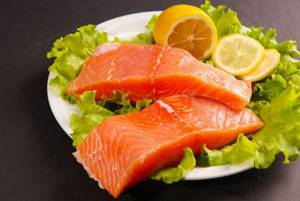
Previously, representatives of the sturgeon family were called “red fish”. Moreover, this name was associated not with the color of the meat, but with its high nutritional and taste value. Today, the category “red fish” includes all fish that have a red tint of flesh, including salmon fish.
There are many varieties of red fish found in Kamchatka:
- Chinook;
- coho salmon;
- chum salmon;
- pink salmon;
- sockeye salmon and others.
Red fish is different:
- excellent taste;
- delicate consistency;
- aesthetic appearance;
- beneficial effects on the body.
Nutritionists advise eating red fish daily, it:
- slows down the aging process;
- strengthens hair and nails;
- rejuvenates the skin.
The product is tasty in any form, it can be:
- marinate;
- salt;
- dry;
- smoke;
- bake;
- boil;
- fry.
The most useful red fish is raw, pickled and salted.
Nutritional value of 100 g of red fish:
- calorie content – 188 Kcal;
- fats – 10 g;
- carbohydrates – 6 g;
- proteins – 20 g.
Red caviar
Red caviar is obtained from salmon species, which are caught in large quantities in Kamchatka. A high-quality product looks very presentable - the eggs are the same size and color, even, undamaged, and easily separated from one another.
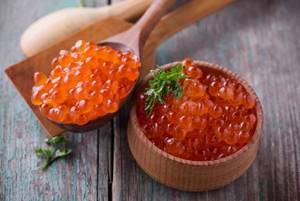
Red caviar is obtained from:
- pink salmon;
- chum salmon;
- trout;
- sockeye salmon;
- Chinook;
- catfish;
- coho salmon
Many people believe that red caviar is inferior in taste and nutrition to black caviar obtained from sturgeon fish. In fact, this product is no less valuable. Salmon caviar has excellent taste and high nutritional value.
Red caviar of different types of fish differs in taste. For example, chum salmon caviar has a soft and rich taste, while sockeye salmon has a piquant and bitter taste. Regardless of the nuances, any red caviar is a valuable delicacy, served both independently and as part of a variety of dishes.
Features of red caviar from different types of fish:
- Pink salmon. It is most often sold in stores. She has light orange eggs of medium size, round and bright.
- Chum salmon. It is considered the most delicious and high quality. She has large eggs of a reddish color, but not as dark as those of trout, coho salmon or sockeye salmon.
- Trout. The grains are bright red, medium size, elastic. It is slightly sticky and has a salty taste, so it is usually used in combination with cream, cheese or sour cream.
- Red salmon. The eggs are bright red. They are much smaller than grains of chum salmon or trout caviar, and have a pronounced bitter taste. Because of these signs, consumers often perceive it as a fake.
Usually caviar is sold in granular form, less often in a bubble film. The product is sold by weight and in canned form. Preference should be given to products packaged as close as possible to the place of production - in Petropavlovsk-Kamchatsky or Yuzhno-Sakhalinsk.
Nutritional value of 100 g of red caviar:
- calorie content – 236 Kcal;
- fats – 13.2 g;
- carbohydrates – 1 g;
- proteins – 28.3 g.
Red caviar became popular around the 19th century. Black caviar was always available in Russia, but red caviar was rarely seen here - it was mined extremely far from the capital. Once upon a time in Kamchatka and Sakhalin, caviar was simply thrown out in tons.
Free fishing in the Kamchatka Territory
Fishing in Kamchatka, this region seems to have been specially created for fishermen. And such an opinion arises not without reason. Not only is the region rich in various rivers and lakes, but trout, mykiss, large char and many other fish species are also found here. And Pacific salmon becomes a dream for most fishermen.
Plus, the region is considered not only “rich” in fish, but also boasts amazingly beautiful landscapes, where all favorable leisure conditions have been created for tourists.
Here are the TOP 10 best places where you can fish for free in the Kamchatka Territory:
Kamchatka River
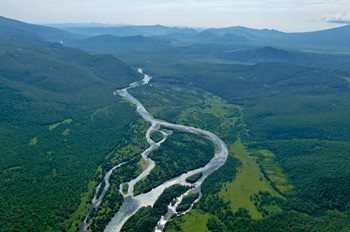
Description, what kind of fish is found, how to get there:
The Kamchatka River (in the upper reaches of Ozernaya Kamchatka) flows through the territory of the Kamchatka Territory and is the largest river of the peninsula. Fishing in the Kamchatka Territory on the Kamchatka River is possible in open water and from ice. The most popular types of fish for fishing on the Kamchatka River are crucian carp, trout, grayling, char, coho salmon, sockeye salmon, Chinook salmon, smelt, flounder, herring, carp, navaga, stickleback, chum salmon, masu salmon and kunja.
GPS coordinates: 56.35992, 160.75899
2. Elovka River
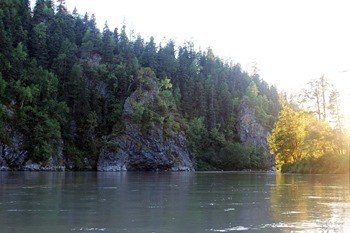
Description, what kind of fish is found, how to get there:
The Elovka River flows through the territory of the Kamchatka Territory and flows into the Kamchatka River on the left, near the village of Klyuchi. Fishing in the Kamchatka Territory on the Elovka River is possible in open water and from ice. The most popular types of fish for fishing on the Elovka River are trout, grayling, char, coho salmon, sockeye salmon, chinook salmon and chum salmon.
GPS coordinates: 56.89263, 160.97688
3. Avacha River
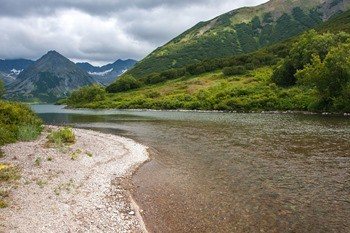
Description, what kind of fish is found, how to get there:
The Avacha River flows through the Kamchatka Territory and flows into Avacha Bay, a bay of the Pacific Ocean. Fishing in the Kamchatka Territory on the Avacha River is possible in open water and from ice. The most popular types of fish for fishing on the Avacha River are char, coho salmon, salmon, chinook salmon and chum salmon.
GPS coordinates: 53.24619, 158.31051
Penzhina River
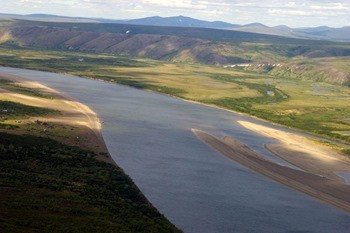
Description, what kind of fish is found, how to get there:
The Penzhina River flows through the Kamchatka Territory and flows into the Penzhina Bay of the Sea of Okhotsk. Fishing in the Kamchatka Territory on the Penzhina River is possible in open water and from ice. The most popular types of fish for fishing on the Penzhina River are rudd, trout, grayling, pike, char, coho salmon, lenok, sockeye salmon, omul, whitefish, chinook salmon, smelt, broad whitefish, stickleback, chum salmon, redhead salmon and kunja.
GPS coordinates: 62.45109, 165.5889
Bolshaya River
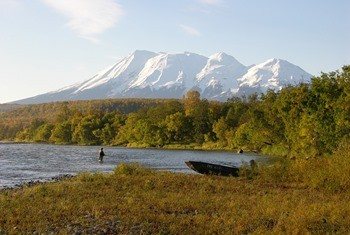
Description, what kind of fish is found, how to get there:
The Bolshaya River flows through the Kamchatka Territory and flows into the Sea of Okhotsk. Fishing in the Kamchatka Territory on the Bolshaya River is possible in open water and from ice. The most popular types of fish for fishing on the Bolshaya River are trout, grayling, char, coho salmon, sockeye salmon, salmon, Chinook salmon, pink salmon and kunja.
GPS coordinates: 52.72035, 156.21603
Lake Nerpichye

Description, what kind of fish is found, how to get there:
Lake Nerpichye is located in the Ust-Kamchatka region, in the eastern part of the Kamchatka Peninsula and is the largest lake. Fishing in the Kamchatka Territory on Lake Nerpichye is carried out in open water and from ice. The most popular types of fish for fishing on Lake Nerpichye are carp (carp), grayling, smelt, herring and salmon.
GPS coordinates: 56.37527, 162.69611
Lake Kurilskoye

Description, what kind of fish is found, how to get there:
Lake Kurilskoye is located in the Ust-Bolsheretsky region, in a large caldera in the southern part of the Kamchatka Peninsula and is the second largest lake. Fishing in the Kamchatka Territory on Lake Kurilskoye is carried out in open water and from ice. The most popular types of fish for fishing on Lake Kurilskoe are sockeye salmon and salmon.
GPS coordinates: 51.455, 157.09018
Saranoye Lake
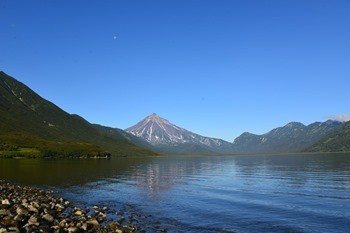
Description, what kind of fish is found, how to get there:
Lake Sarannoe is located in the Aleutian region, on Bering Island and is the largest freshwater lake on the island. Fishing in the Kamchatka Territory on Saranoye Lake is carried out in open water and from ice. The most popular types of fish for fishing on Saranoye Lake are coho salmon, sockeye salmon, pink salmon, salmon and chum salmon.
GPS coordinates: 55.27694, 166.13638
Lake Dalneye
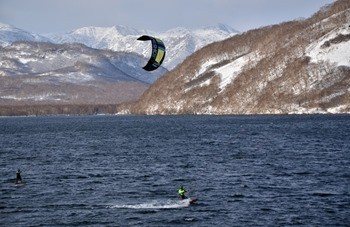
Description, what kind of fish is found, how to get there:
Lake Dalnee is located in the Elizovsky district, approximately 7 kilometers southeast of the village of Paratunka. Fishing in the Kamchatka Territory on Lake Dalneye is carried out in open water and from ice. The most popular types of fish for fishing on Lake Dalneye are tench, char and salmon.
GPS coordinates: 52.93333, 158.33333
Lake Nachikinskoye
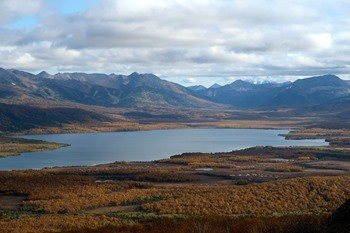
Description, what kind of fish is found, how to get there:
Lake Nachikinskoye is located in the Elizovsky district, about 13 kilometers from the village of Nachiki. Fishing in the Kamchatka Territory on Lake Nachikinskoye is carried out in open water and from ice. The most popular types of fish for fishing on Lake Nachikinskoye are char, coho salmon, sockeye salmon and pink salmon.
GPS coordinates: 52.99803, 157.85057
Do you know any other good places for fishing in the Kamchatka Territory - write in the comments
